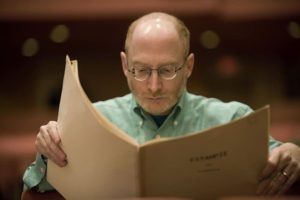Nashville Symphony presents Kernis, Barber, and Beethoven
This past weekend The Nashville Symphony presented a true cornucopia of musical selections: a contemporary new work by Jay Kernis, a challenging and versatile cello concerto by Samuel Barber, and a classic masterwork by Ludwig van Beethoven. In a way, what was presented during a somber and rainy week in Nashville felt as though you were stepping into a museum of varying works of art. The program was diverse and thoughtfully put together, presenting a wide array of selections running the gamut from 19th-century classical polyphony to 21st-century grit that leaves you lost in thought, wishing for more, and then utterly satisfied by the time you reach Beethoven’s finale.

The night began with ‘Chromelodeon’, a new work by New York City-based composer Aaron Jay Kernis. As if his Pulitzer Prize in Music and 2019 Grammy nomination weren’t enough to catch the audience member’s attention, surely the chromatic and otherwise hectic first movement that unfolds was sure to do the trick. The composer describes the piece as “chromatic, colorful, melodic music performed by an orchestra.” Another way that the composer describes the aurora of this piece is how his composing reflects the emotional tenor of the time in which he writes. He hints at “the influence of living in the chaos of the world today” and how this might play a role “at a ‘molecular’ emotive level.” Truly this mood and overall chaos are evident throughout the piece. Whether it be in the “colorful” sounds of the bells at the beginning, or in the operatic second movement which switches from a theme after Handel into a tradeoff of dark melodies between violin and viola that eventually decomposes into nothingness. All of this leads up to the final movement: where harmony and chaos seem to fight until the piece ends abruptly, with a loud outburst open fifth of F and C. Kernis’ ‘Chromelodeon’ is an unabashed, contemporary work of art that must be experienced live to truly understand every facet and intricacy of the work.

The evening then segued to an even broodier, pensive, and extremely challenging work by Samuel Barber. A composer known for his beautiful and aching melodies can also somehow compose a concerto so challenging very few orchestras can muster the talent to perform it. This being the first performance for the Nashville Symphony, one can also expect that the orchestra was just as excited to play it as Maestro Guerrero was to conduct it. Couple this energy with world-class cellist Alban Gerhardt, and what was presented was a mesmerizing performance that paired wonderfully with the contemporary piece before it. Gerhardt’s playing was sensitive and so delicate in the high register, that if one were to close their eyes during the aggressive and fierce sections, it’s possible that one could imagine a completely different soloist had entered the stage. The accompanying Nashville Symphony relish their opportunities, with exuberant, attacking violins in the first subject and eager response to the finale’s more angular dissonances. Guerrero seems on top of every aspect of this score and, while the performance is not always as expansive as it might be, the playing was superb. Woodwinds, especially principal oboe Titus Underwood, truly shines just as much as the outstanding cellist.
The Nashville Symphony concludes the evening by choosing one of the less flashy, less complex Beethoven symphonies: The Seventh. As if the two compositions prior weren’t enough to show off the orchestra’s brawn and musicality, they continue by playing with an exuberant energy that was still present yet. In particular Nashville Symphony fashion, the orchestra showed that they can perform a new contemporary American composition as well as a Classical masterwork on the same concert without sacrificing style and artistic clarity. From the get-go, Beethoven’s Seventh Symphony is notable in the composer’s oeuvre for its rhythmic, joyous spirit — a contrast to his other symphonic works, which tend to unfold as epic journeys from darkness to light. It seemed this programming was quite purposeful (the audience is surely yearning for that traditional harmony and satisfying cadences by now). And the players delivered a remarkable first movement that was gleaming with excitement and energy.
As the rest of the work unfolds, Beethoven uses harmony and rhythm together to unify each movement and bind them one to the other. The melancholy, darker second movement is one that provides a brief reprieve from the light-hearted outer movements. Sprinkled with moments of delicate counterpoint in between the swells, this movement requires transcendent balances between each section. And every symphony member delivered. In stark contrast, the third movement Presto takes the form of contredanse, an unrefined but popular dance style. Presto indeed, Guerrero used this movement to show off his orchestra’s ability. Even, in certain spots, stopping his baton all together to allow the orchestra to take control. The work closes with a mighty finale that modern commentator Maynard Solomon interpreted as “a critique” that “undermines the precepts of a calm and symmetrical Classicism, preferring those dynamic polarities of tranquility and terror, containment and abandon, and dream and intoxication that Nietzsche later identified as ‘the Apollonian-Dionysian duality.’” The mighty piece sounds forth and forth until orchestra reaches utter climax, concluding in triumph that calls for a Bravi and immediate standing ovations. Overall, one could say that this was a solid evening of varying and challenging music by Music City’s finest.



Great Review! I agree that Gerhardt played the Barber wonderfully, but my favorite overall was the Pilgrim’s Hymn in the third movement of the Beethoven. Maestro brought it out in such an astoundingly beautiful way! And it was great to see (on Thursday at least) Gerhardt join the band for the Beethoven…A true lover of music! It really was a fun night!!!